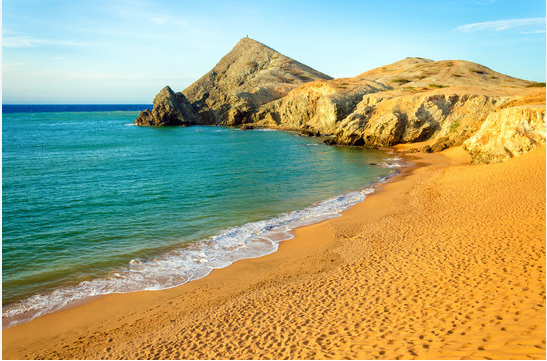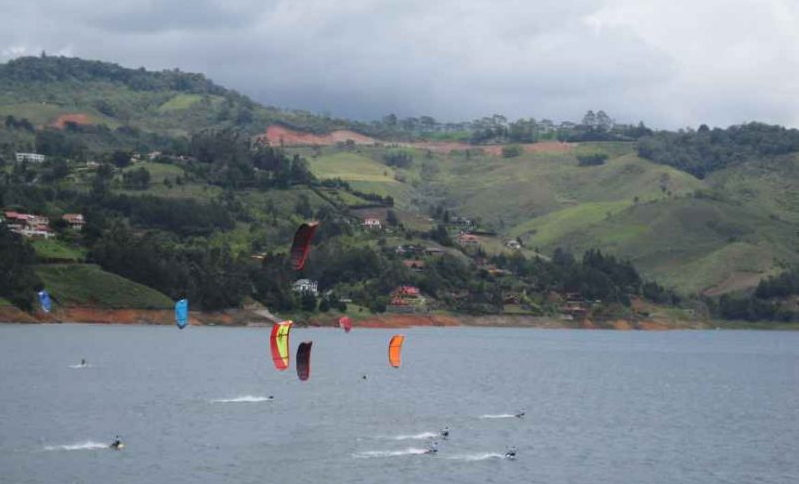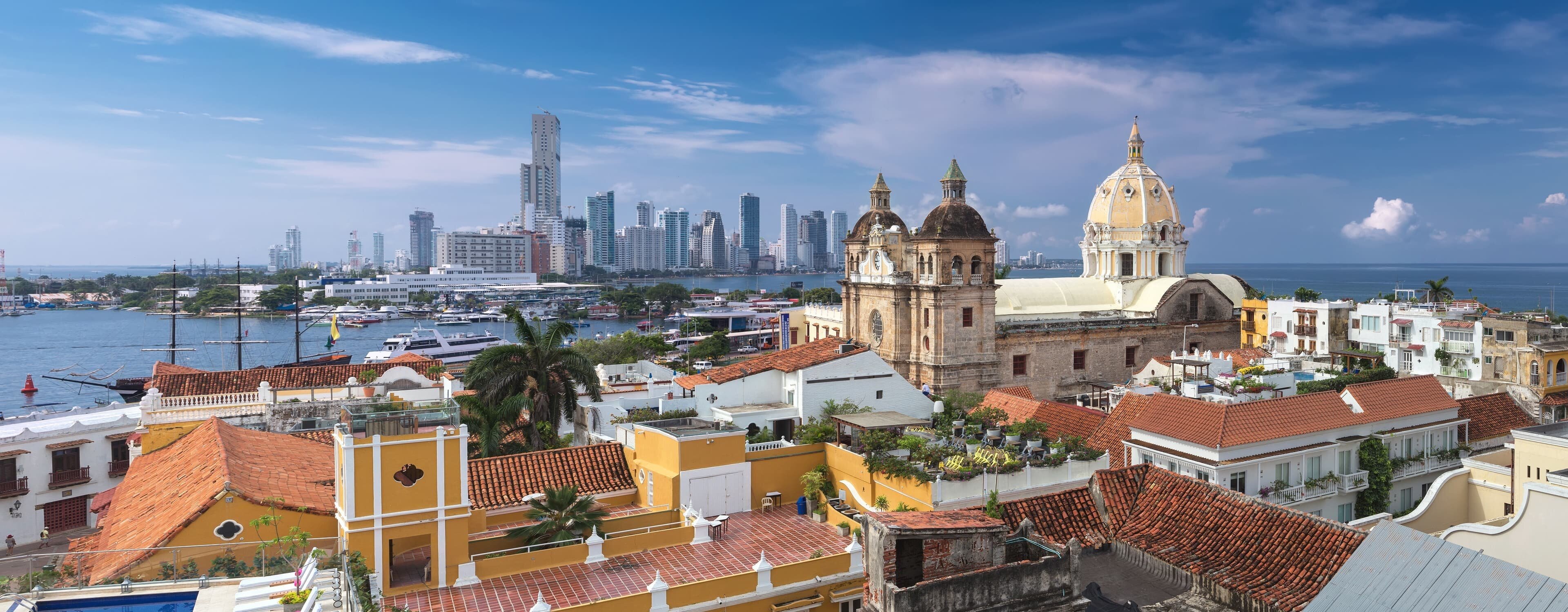Tranquil historic towns, welcoming locals, towering mountains, the Amazon rainforest, rivers, valleys, waterfalls, and vast stretches of coastline on the Caribbean Sea and the Atlantic Ocean are what strike travelers when they first visit Colombia. Besides unparalleled landscapes and sunsets, Colombia offers a vacation full of adventure and adrenaline while practicing watersports such as kitesurfing.
HIGHLIGHTS OF COLOMBIA
BIODIVERSITY
Colombia is one of the most biologically and culturally diverse countries around the world. It is estimated to possess 15% of the biodiversity on the planet, meaning it has the highest number of flora and fauna species by area in the world. You can find vibrant cities, the Tatacoa Desert, coffee plantations, volcanos, and even snowy areas in its borders.
GASTRONOMY
Colombian gastronomy is as diverse as its nature and cities and can be defined as a fusion of other cultures, mainly Spanish and African, complemented with typical dishes of each region of Columbia. Typical Colombian dishes such as bandeja paisa, mote de queso costeño, sancocho, arepa, mute santandereano, and carne a la llanera (among many other Colombian gastronomic delicacies) will certainly be a delight.
NATIVE CULTURE
Colombia is one of the countries with the greatest number of native tribal communities in Latin America. With over 100 ethnic groups, 65 of whom have retained their own native languages. Recognizing, caring for and preserving their cultural life and wisdom is essential for the retention of Colombia’s history.
MUSIC
Columbia is named the land of a thousand rhythms. From African beats, Spanish and European influences, to tribal sounds, you can find everything. The Cumbia and Bambuco are the most representative dances of the country abroad. Amongst other popular genres, there is also the Salsa, Champeta, Salsa Choke, Bullerengue, Curralao, and Vallenato.
KITESURFING IN COLOMBIA
Columbia as a kite destination has enormous potential. It is gaining more and more followers to the sport everyday, and people are squeezing the best out of it. The motives? Colombia has close to ideal wind conditions, diverse spots, and more and more options for lodging and learning centers. For strong wind lovers, Santa Veronica or Cabo de la Vela are the spots to go. If you like green hills and calm murky water, you can go to Lago Calima. San Andres will allow one to kitesurf in turquoise blue water. The water in the Caribbean is clear and still, and in the Pacific, fairly wilder. You can also experience some really fantastic and exciting kitesurfing spots in the Pacific Ocean. Jump into the waters, test your spirit of adventure, and take off in big jumps. Recently, Colombia has become the first stop on the GKA world tour. The tour continues to 16 more destinations, from Dakhla (Morocco) to Fuerteventura (Spain) and Ceará (Brazil). Overall, Colombia is one of the most worthwhile kitesurfing destinations to visit on a kitesurfing trip to South America!
WHEN IS THE BEST TIME TO KITESURF IN COLOMBIA
In Cabo de la Vela the wind is especially strong and blows between 25 and 35 knots continually. The low wind season is from May to June, and the unstable and gusty wind blows from 15 to 25 knotsalthough it hardly ever blows less than 15 knots. The prime time to kitesurf is very early in the morning or later in the afternoon when you can expect steady winds.In Cartagena, the main season starts in the month of December and ends at the end of March. Santa Veronica is comparable to Cartagena but has a second season from June to August. Calima Lake has navigable winds 360 days a year and offers a warm tropical climate, making it the water sports capital of Colombia. The weather, on a warm day, can be between 27 and 35°C, and in a cooler season it can range between 20 and 27°C.
WHAT ARE THE BEST KITESURF SPOTS IN COLOMBIA?
Cabo de la Vela

This spot is particularly remote and it takes around 3 hours to drive from the last city Uribia, desert of Guajira. The region is home to the Wayuus tribe. Wayuu means ‘people of the sun, sand and wind.’ And indeed, the wind is strong and the direction is offshore. Suitable for more experienced kitesurfers, Cabo de La Vela is also a well-known tourist attraction for surfers and non-surfers alike, as it not only offers the option to practice water sports, but also has splendid landscapes with lodgings in front of the beach and local premeval ranches.
Santa Veronica

Santa Veronica, situated 45 minutes from Cartagena, is an area increasingly attracting kitesurfing enthusiasts to enjoy a good surf, allowing them to advance in the wave mode.It is definitely a wave spot, with strong winds up to 45 knots, and is great for big air and strapless freestyle. The climate is typically humid and tropical with an average temperature of 30°C.
Mayapo, RiohachaMayapo is another remote area that provides plenty of space to practice kitesurfing. It is located next to the capital of the tribal territory de los wayuus Riohacha. Riohacha is a city that you cannot miss for its unique combination of desert, sea, and culture—which is the attraction of the city. This spot is windy almost all year round, and the season runs from December to August with September/October being the least likely months due to the heavy rains.
Lago Calima

Roughly 2 hours north of Cali is Lake Calima, which attracts kite and windsurfers throughout the entire year due to the consistant wind conditions. Due to its geographical position, this place receives winds of up to 43 knots, making it the third lake in the world to have extremely strong winds—and the first in America. The lake is widely known as one of the largest artificial lakes in Colombia. This is an extra-mystic kite spot that offers a high chance of kiting with rainbows, as it is often foggy.
Cartagena
One of Colombia's tourist attractions is the city of Cartagena, which not only stands out for its historic old town, its gastronomic attractions, and its great nightlife, but also for its beaches. It is perfect for kitesurfing and suitable for all levels. Between December and April you can kite at different spots close to the city. The closest spots are La Boquilla and El Laguito. You can go to Manzanillo (a 30 minute drive from city center) where the beach is emptier and prettier.
San Andrés
San Andrés is an exotic island with a sea of seven colors positioned further away from Columbia mainland in the Caribbean ocean. Due to its intertropical setting, the archipelago is distinguished by a hot climate that registers an annual average of 27.3°C. Hundreds of kitesurfers take advantage of the constant strong winds (of more than 18 knots coming from the north), and crystal clear, warm and choppy water to glide, jump, and fly over.
Macanal, BoyacaIt is no wonder that, in Colombia, kitesurfing is being practiced mainly on the coast in the ocean. But a few years back (and fortunately for the locals of Bogota), there is a new destination for kitesurfers that is hitting hard: the Macanal in Boyacá. The best time to go is between November and March, because the wind is good almost every day.
ABOUT THE COUNTRY
A Brief History of Colombia
Much of Colombia's history is closely connected to the history of Spain until its independence (discovery, conquests and colonization), where in 1886 Colombia emerged, like the other Latin American countries, as a unit with a claim to political independence following the Napoleonic invasion of the Iberian Peninsula. Throughout the 19th century, Colombia's path was mainly concentrated on the presence of two political-administrative trends: political centralism and federalism. The country experienced political tension and several civil wars until the so-called War of the Thousand Days in 1902 when the twentieth century started and made the country more prosperous. Gold mining and primary products such as tobacco were the basis of the economy until the coffee export cycle began. But despite sustained economic growth, the current Republic of Colombia is still highly unequal in income and opportunities. Drug-related violence and corruption serves as an obstacle to further growth, as well as deficiencies in education and infrastructure, which hinders insertion into the world economy.
Things to Do When There’s No Wind
There are times of the day when you cannot kitesurf, and these are the perfect times to experience the wonders of Colombia. The country surprises with its multiformity of landscapes, from as deserts to idyllic Caribbean beaches to lively cultural cities. Whatever you are looking for, you will find it in Columbia.As a result, you can enjoy the city life in Medellin, Cartagena, and Bogotá y Cali. Those are undoubtedly the most picturesque cities in the country. Take, for example, strolling through the historic center of Cartagena, with its narrow streets full of life, color, and atmosphere. It will be one of the great places amongst many others to see in Colombia.The capital of Colombia is another must-see. The Plaza de Bolívar, Barrio de la Candelaria, and the Plaza del Chorro de Quevedo, is where you will be able to see some of the coolest urban street art.Adventure seekers and nature fans can get in kayaks or boats and reach extraordinary waterfalls, hit some trails to walk and enjoy the vegetation, and (during the summer) sunbathe.Among the wide variety of activities available, the Colombian Amazon stands out. There, you can see animals in the wild or go fishing for piranhas. The Mundo Amazónico Ecological Park and Cahuinari National Natural Park are places where outsiders can observe the best of the Amazon's flora and fauna.
Getting to Colombia
There are several alternatives for routes to Colombia depending on your starting location. Most visitors arrive in Colombia by plane at one of the four main international airports: Bogota, Medellin, Cartagena, or Cali. Also, Colombia has borders with Panama, Venezuela, Brazil, Peru, and Ecuador, but there are only road connections with Venezuela and Ecuador. From Ecuador, Venezuela, and Panama, it is possible to arrive by car. Keep in mind that the road from Panama to Colombia has a jungle stretch in between, and cars must be shipped by boat to one of the Colombian ports. Cartagena, due to its privileged position, has an embankment port for not only cruise lines that travel the Caribbean, but also for sailboats, yachts, and other vessels. Unfortunately, there are no international rail connections.
USEFUL RESOURCES
Colombia
